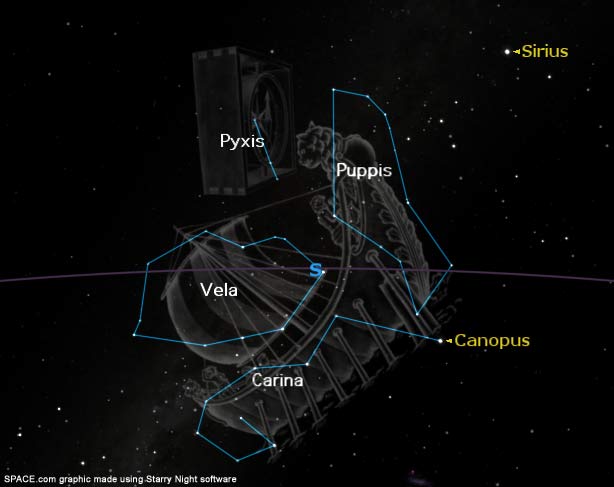
As darkness falls this week, the evening sky of early spring is dominated in the northeast by a very large constellation, Ursa Major, the Great Bear, and in the southeast by Leo, the Lion, containing the bluish-white 1st-magnitude star Regulus.
And not too far to the west of Regulus, is a cream-colored "star" with a steady glow, shining nearly three times brighter than Regulus. But that "star" is, in reality, the ringed planet Saturn, now past opposition and favorably placed for viewing for much of the night.
Ursa Major is indeed one of the largest constellations, but at one time there was a constellation in our spring sky that was even larger. It is the star pattern that the ancients made into the huge constellation of Argo Navis, the Ship, which currently occupies most of the sky down near the south and southwest horizon early evenings. But you'll be looking in vain for the name Argo on modern sky charts, for it officially passed out of existence in 1930, when the International Astronomical Union (IAU) defined the presently recognized constellations and their boundaries.
The IAU broke Argo up into four separate parts: Puppis the Stern, Vela the Sails, Carina the Keel, and Pyxis the Mariner's Compass. The stars that comprise this last group actually belonged at one time to the non-defunct Malus the Mast [sky map].
Interestingly, in his classic star guide, "The Stars-A New Way to See Them" (Houghton-Mifflin Co., Boston), the late H.A. Rey kept Argo intact, referring to it simply as "The Ship," and describing it as "A large majestic group."
Argo was regarded as a ship by several early civilizations and has often been thought of as Noah's Ark. About 5,000-years ago it appeared farther north than it does now, thanks to wobbling motion of the Earth on its axis known as precession. Ancient stargazers located in Greece and Asia Minor would see this celestial ship sailing westward-albeit stern first (Rey suggested that perhaps the ship was trying to correct an error in navigation)-and along the Mediterranean horizon as the night progressed.
In Greek mythology the Argo carried Jason and his 50 Argonauts to Colchis at the eastern end of the Black Sea, to recover the Golden Fleece. The goddess Athena, who procured a magical oaken prow that had the powers of thought and speech that was thereby able to guide the crew, supervised the ship's construction. But at launching time, the vessel refused to slide into the water until Orpheus charmed it with his lyre, one of a number of feats he performed with that instrument (now commemorated in our summer sky by the constellation Lyra).
Get the Space.com Newsletter
Breaking space news, the latest updates on rocket launches, skywatching events and more!
In Carina, we find the brilliant yellow-white star, Canopus, the second brightest in the night sky, next to Sirius.
Skywatchers who live south of the equator may be well acquainted with four stars in this part of the sky-two belonging to Vela and two belonging to Carina-known collectively as the "False Cross." Not only do these four stars bear a superficial resemblance to the true Southern Cross (Crux), but, it is even oriented in roughly the same way though positioned farther to the north. Hence an uninitiated observer might easily mistake the False Cross for the true one, but only the latter points to the south celestial pole (matching the Pointers of the Big Dipper in this respect). Crux is also honored on the flags of such countries as Australia and New Zealand, and on numerous postage stamps.
Yet the False Cross will have its time of glory 66 centuries from now, in the year 8600, when the pole will have precessed to a point just east of the cross-arms' intersection. By then, perhaps when our descendants are asked where the South Pole of the sky is located, all they need do is say "X" marks the spot!
Basic Sky Guides
- Full Moon Fever
- Astrophotography 101
- Sky Calendar & Moon Phases
- 10 Steps to Rewarding Stargazing
- Understanding the Ecliptic and the Zodiac
- False Dawn: All about the Zodiacal Light
- Reading Weather in the Sun, Moon and Stars
- How and Why the Night Sky Changes with the Seasons
- Night Sky Main Page: More Skywatching News & Features
Joe Rao serves as an instructor and guest lecturer at New York's Hayden Planetarium. He writes about astronomy for The New York Times and other publications, and he is also an on-camera meteorologist for News 12 Westchester, New York.
Join our Space Forums to keep talking space on the latest missions, night sky and more! And if you have a news tip, correction or comment, let us know at: community@space.com.

Joe Rao is Space.com's skywatching columnist, as well as a veteran meteorologist and eclipse chaser who also serves as an instructor and guest lecturer at New York's Hayden Planetarium. He writes about astronomy for Natural History magazine, Sky & Telescope and other publications. Joe is an 8-time Emmy-nominated meteorologist who served the Putnam Valley region of New York for over 21 years. You can find him on Twitter and YouTube tracking lunar and solar eclipses, meteor showers and more. To find out Joe's latest project, visit him on Twitter.









